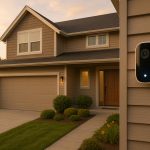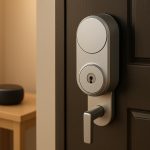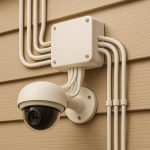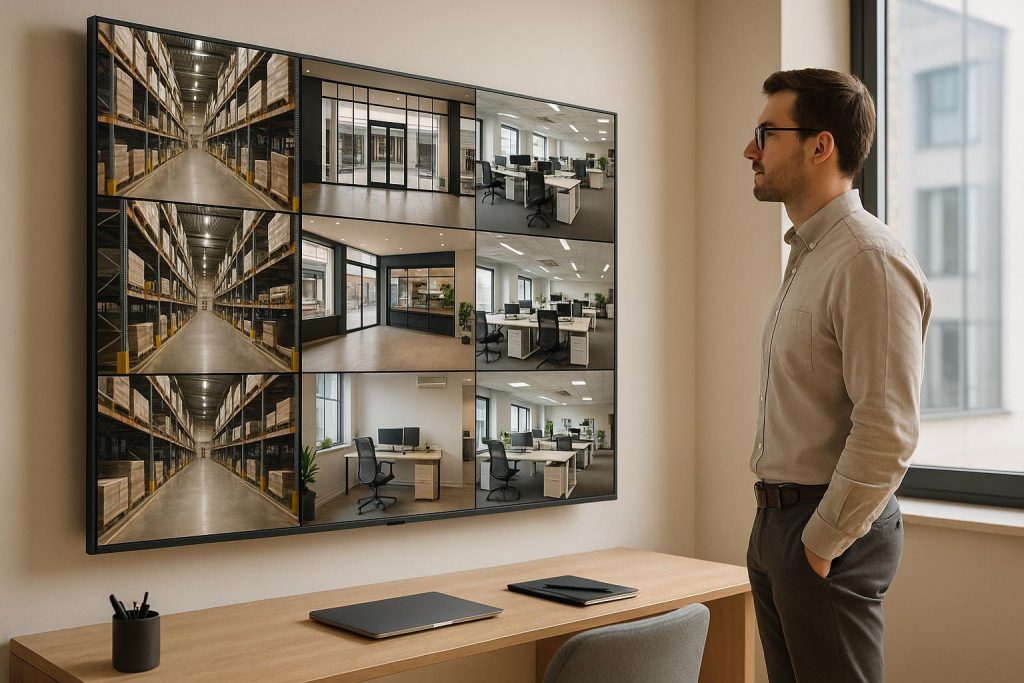Remote video monitoring allows businesses to oversee their operations and secure assets in real-time, no matter where they are. By connecting cameras to a network or cloud-based storage, users can access live feeds, review footage, and receive alerts via smartphones or computers. This technology has evolved from outdated analog systems to high-definition, AI-powered solutions that offer features like motion detection, facial recognition, and automated alerts. Besides improving security, it helps monitor employee performance, enforce safety protocols, and optimize customer interactions.
Key Takeaways:
- What It Is: A system for managing surveillance remotely via internet-connected devices.
- Why It’s Useful: Reduces costs, increases safety, and enables real-time responses.
- Modern Features: AI analytics, mobile access, and integration with existing security systems.
- Setup: Involves cameras, storage (on-site or cloud), and software for monitoring and alerts.
- Storage Options: On-site (local control) or cloud (scalable, subscription-based).
- Choosing a Provider: Look for certified technicians, 24/7 support, and integration expertise.
Remote video monitoring is a smart solution for businesses looking to strengthen security, streamline operations, and gain actionable insights.
Dummies Guide to Remote Viewing an IP Security Camera
Main Parts of a Remote Video Monitoring System
As video monitoring technology continues to advance, understanding its core components is crucial for enhancing business security. A remote video monitoring system is made up of several key elements that work together to provide comprehensive surveillance. Knowing how these parts function can help businesses make smarter decisions about their security investments and maximize the system’s potential.
Hardware: Cameras and Storage Options
At the heart of any remote monitoring system are its cameras. Modern setups typically rely on IP cameras, which deliver high-definition video and offer flexible installation options. These cameras can transmit footage via Ethernet cables or Wi‑Fi, making them far more versatile than older analog systems.
When choosing cameras, it’s important to find the right balance between resolution and storage needs. Higher resolutions, like 4K, provide incredibly detailed footage but also produce larger file sizes, which can drive up storage costs. For businesses that operate around the clock, night vision capabilities are critical. Infrared cameras can capture clear footage in complete darkness, often up to distances of 100 feet, while starlight-enabled models can even produce color images in very low-light conditions.
Storage is another essential component, and businesses have three main options:
- Network Video Recorders (NVRs): These store footage locally on hard drives, offering full control over data. For instance, a 4TB drive can hold about 30 days of footage from four 1080p cameras.
- Cloud Storage: This eliminates the need for physical storage on-site and provides automatic backups, though it typically requires a monthly subscription.
- Hybrid Systems: These combine the best of both worlds by storing recent footage locally while backing up critical clips to the cloud.
With the right hardware in place, the system’s software takes over to transform raw video into actionable insights.
Software Features for Monitoring and Analytics
The software in a remote video monitoring system is where the magic happens. It processes video feeds and turns them into valuable security insights. A central management dashboard allows users to view multiple camera feeds, search through recorded footage, and manage system settings – all from one convenient location.
Advanced motion detection features are a game changer. These systems can now differentiate between people, vehicles, and even animals, significantly reducing false alarms. Some software can also identify specific behaviors, such as loitering or unauthorized items being left in restricted areas.
Mobile apps bring real-time monitoring to your fingertips. Push notifications alert you to critical events as they happen, and you can access live feeds or recorded clips from anywhere with an internet connection. Many apps also support two-way audio, enabling communication through cameras equipped with microphones and speakers.
Beyond security, video analytics can provide valuable business insights. Features like heat mapping show which areas of your facility see the most foot traffic, helping with layout optimization. People counting tracks visitor flow, while dwell time analytics reveal how long customers spend in different areas.
Facial recognition technology adds another layer of functionality. It can identify employees, VIP customers, or even flag unknown individuals in restricted zones. However, it’s essential to comply with privacy laws and regulations when using such features.
Once the software is set up, integrating it with other security systems ensures a seamless and efficient operation.
Connecting with Existing Security Systems
To create a truly comprehensive security setup, remote video monitoring systems should integrate with existing measures. For example, connecting cameras with alarm systems ensures that recording starts automatically when motion sensors or door contacts are triggered.
Access control integration is another powerful feature. By linking your video system with keycard readers or door locks, cameras can focus on specific areas as people badge in, creating a complete audit trail of access activities.
Intrusion detection systems can also interact with cameras. If a perimeter breach occurs, outdoor cameras and spotlight systems can activate immediately. Similarly, an internal motion detector can trigger recording and notify security staff.
Integration with fire safety systems can enhance emergency response. When smoke detectors go off, cameras can record evacuation routes, providing vital information to first responders. This is especially useful in large facilities, where visual confirmation can guide quicker, more effective action.
Additionally, third-party software integrations can unlock even more functionality. For instance, syncing cameras with point-of-sale systems can help prevent theft and resolve disputes by recording transactions. Building management systems can also connect lighting, HVAC, and security cameras to optimize energy use while maintaining robust security coverage.
To ensure smooth integration, look for systems that support standard, compatible protocols.
How to Set Up Remote Video Monitoring Step by Step
Setting up a remote video monitoring system requires careful planning to ensure your business security needs are met. A well-thought-out approach helps avoid costly mistakes and guarantees your system is effective from the start.
Planning and Needs Assessment
Start by defining your surveillance goals. What do you want your system to achieve? Whether it’s receiving delivery alerts, capturing evidence of unauthorized activities, monitoring employee safety, or deterring crime, having clear objectives is essential. As Security Alarm notes, "It’s impossible to plan a system without goals and objectives."
Next, conduct a risk assessment to identify vulnerabilities across your property. Use tools like the FBI’s National Incident-Based Reporting System, which provides an interactive map of local crime rates and types, to understand the specific risks in your area. ECAM emphasizes the importance of this step: "A risk assessment takes an inventory of all your business assets to determine what needs protecting. One of its goals is to close any security holes."
Carefully plan camera placements to maximize coverage and prevent tampering. Test different setups before finalizing installation to ensure you’re covering all critical areas effectively.
Evaluate your network capabilities, including Ethernet cabling, Wi-Fi strength, available switches, and upload bandwidth. Keep in mind that a single 1080p camera typically requires 2–4 Mbps of upload bandwidth, so a network upgrade might be necessary if you’re using multiple cameras. Consider power supply options as well – Power over Ethernet (PoE) can simplify installation by combining power and data in one cable.
Budgeting is another critical step. Beyond camera costs, which can range from under $100 for basic models to thousands for advanced systems, you’ll also need to account for software licensing, storage solutions, network upgrades, installation fees, and ongoing maintenance. High-end business systems often start around $1,500.
Once you’ve mapped out your needs and placements, you can decide whether to handle the installation yourself or hire a professional.
Installation: Professional vs. DIY
Choosing between professional installation and a DIY approach depends on your budget, technical expertise, and the complexity of your setup.
Professional installation offers peace of mind. Experts ensure proper camera positioning, configure your network, and integrate the system seamlessly. They’re also better equipped to handle advanced setups, such as integrating with access controls or building management systems. Professional services often include warranties on equipment and labor, along with ongoing technical support – making them a strong choice for businesses with multiple locations or complex requirements.
On the other hand, DIY installation can save on labor costs but requires a solid understanding of network protocols, power requirements, cable types, and software configuration. It’s generally better suited for smaller setups with straightforward layouts. However, DIY projects come with risks, such as improper camera placement leading to blind spots, inadequate weatherproofing, or network errors that could compromise security.
Whichever route you choose, the next step is enabling secure remote access to unlock the full potential of your monitoring system.
Setting Up Remote Access
Remote access takes your video monitoring system to the next level, allowing you to oversee your property from anywhere. However, it’s crucial to set it up securely to avoid exposing your network to cyber threats.
Start by configuring your router to use non-standard ports and enable WPA3 encryption. Isolate camera traffic by setting up a dedicated VLAN. Make sure your internet connection can handle the required upload bandwidth – around 1–2 Mbps per camera for smooth remote streaming.
Set up individual user accounts with role-based access controls. For example, administrators might need full access, while managers only require live viewing, and security staff might only need access to specific camera feeds during their shifts.
Implement two-factor authentication to add an extra layer of security. Regularly update passwords and conduct account audits to maintain system integrity over time.
Data encryption is another key step. Use SSL/TLS protocols for all remote connections and ensure recorded footage is protected with AES-256 encryption. If you’re using cloud storage, verify that the provider offers end-to-end encryption, with encryption keys managed separately from the stored video data.
Finally, test remote access across all devices to ensure smooth functionality. Keep your system secure with regular updates, two-factor authentication, and periodic audits to address potential vulnerabilities.
Benefits of Remote Video Monitoring for Businesses
Once the setup and integration are complete, the true advantages of remote video monitoring come to life. This technology transforms how businesses approach security and operations. The ability to oversee your property from virtually anywhere provides benefits that go far beyond what traditional surveillance systems can offer. These systems not only enhance safety but also improve efficiency across the board.
Better Security and Incident Response
Remote video monitoring provides real-time threat detection, which can stop losses before they happen. The ability to detect threats as they occur allows for swift action.
With immediate response capability, businesses can act quickly when an incident arises. Alerts can notify law enforcement or trigger on-site deterrents, ensuring that small issues don’t escalate into major problems.
Continuous monitoring ensures your property is protected 24/7 without the need for on-site personnel. The cameras work around the clock, delivering consistent coverage regardless of the time or conditions.
The system also improves the quality of evidence. High-definition footage with timestamps can serve as strong evidence for insurance claims or legal cases. Modern systems capture clear details like license plates and facial features, which older analog systems often couldn’t.
Visible cameras and active monitoring create a deterrent effect as well. When potential intruders see that a property is under watch, they’re more likely to move on, reducing the chance of break-ins or other security incidents.
Improved Operations and Cost Savings
Remote video monitoring doesn’t just enhance security – it also streamlines operations and reduces costs.
- Centralized monitoring allows one person to oversee multiple locations, cutting down on labor expenses. Instead of staffing security teams at each site, everything can be managed from a single hub.
- False alarms are reduced thanks to advanced video analytics that can distinguish between real threats and harmless events like animals or weather, ensuring emergency responders are only called when necessary.
- Some insurance providers offer policy discounts or incentives for businesses with professional monitoring systems, helping offset the cost of installation and maintenance.
Beyond security, these systems provide operational insights. By tracking daily activities, businesses can identify inefficiencies, ensure compliance with safety protocols, and allocate resources more effectively. This data-driven approach can reveal cost-saving opportunities that might otherwise go unnoticed.
Remote troubleshooting is another key feature. Technicians can access systems remotely to diagnose and fix issues, reducing the need for on-site visits and minimizing downtime.
Business Intelligence and Advanced Features
Modern video monitoring systems go beyond security by offering tools that enhance business intelligence.
- AI-powered analytics turn video footage into actionable insights. These systems can count visitors, track dwell times, and identify unusual behavior patterns, helping businesses optimize staffing and operations.
- Automated alerts focus attention on critical issues, such as unauthorized after-hours access or vehicles in restricted areas, without requiring constant manual oversight.
- Integration with other technologies allows systems to work alongside access control, point-of-sale data, and building automation, creating a unified view of operations.
For retail businesses, features like heat mapping and traffic analysis provide insights into customer behavior. By identifying high-traffic areas and bottlenecks, businesses can adjust layouts to improve the shopping experience.
Predictive maintenance is another game-changer. Cameras can monitor equipment and infrastructure, using AI to spot potential problems before they become expensive repairs.
Compliance monitoring ensures safety regulations and internal policies are followed. Automated systems can verify that employees are wearing safety gear or following procedures, reducing liability risks and improving workplace safety.
Historical analysis offers long-term data that helps refine both security and operational strategies. Whether it’s identifying seasonal trends, measuring the success of security measures, or linking incidents to operational changes, this data adds value over time.
Finally, the scalability of these systems means they grow with your business. Expanding to new locations or upgrading existing systems is often seamless, especially with cloud-based platforms that maintain centralized control and consistent features across all sites.
sbb-itb-643e28e
On-Site vs. Cloud Storage: A Comparison
Choosing the right storage solution is just as important as selecting the hardware and software for your remote video monitoring system. At the core of this decision lies a key choice: on-site storage or cloud-based storage. Each option comes with its own set of advantages and challenges, impacting everything from cost to security and operational efficiency.
On-site storage involves using Digital Video Recorders (DVRs) or Network Video Recorders (NVRs) installed at your location. These systems store footage locally, either within the recording device itself or on dedicated storage servers. The key benefit? You have full physical control over your data. However, this also means you’re responsible for maintaining the equipment and securing the data.
Cloud storage, on the other hand, shifts your video footage to third-party-managed remote servers. Your cameras send data over the internet to secure data centers, where it’s stored and accessible via online platforms. This option reduces the technical burden and makes accessing your footage more convenient.
The financial aspect also differs significantly between the two. On-site storage requires a larger initial investment in hardware but has minimal recurring costs. Cloud storage, while cheaper upfront, usually involves subscription fees for ongoing storage and remote access.
Comparison Table
| Factor | On-Site Storage (DVR/NVR) | Cloud Storage |
|---|---|---|
| Initial Cost | Higher upfront investment for hardware and storage devices. | Lower upfront cost, often bundled with camera systems. |
| Monthly Cost | Minimal recurring costs, mostly for maintenance. | Subscription fees for storage and remote access. |
| Scalability | Limited by physical hardware; upgrades require new equipment. | Flexible storage that grows with your needs. |
| Remote Access | Requires manual setup for remote viewing. | Built-in remote access via apps and web platforms. |
| Maintenance | Requires regular upkeep of hardware and software. | Managed by the service provider, reducing workload. |
| Data Security | Relies on local security measures, vulnerable to physical risks. | Uses encryption and redundant backups for protection. |
| Internet Dependency | Local recording continues during outages, but remote access is affected. | Requires constant internet for uploading and access. |
| Storage Capacity | Fixed by hardware limitations. | Scalable storage adjusts to your usage. |
| Data Retention | Limited by hardware, leading to potential overwrites. | Customizable retention periods based on your plan. |
| Setup Complexity | Involves technical setup, including network configuration. | Simple plug-and-play setup. |
| Reliability | Dependent on local hardware, with potential single points of failure. | Redundant systems minimize downtime and data loss. |
Key Considerations
Your choice between on-site and cloud storage will shape how scalable, accessible, and resilient your system is. For instance, on-site systems primarily use bandwidth for remote viewing, while cloud systems require constant uploading. This means cloud storage might demand a stronger internet connection or adjustments to your current plan.
Ownership and privacy also play a big role. On-site storage ensures your footage stays directly under your control, which can be a major advantage for sensitive data or strict compliance needs. Cloud storage, however, relies on third-party providers who typically implement advanced encryption and security protocols to safeguard your data.
Ease of use is another differentiator. On-site setups often require a deeper understanding of networking for proper configuration, making them more complex to manage. In contrast, cloud-based systems are designed to be user-friendly, catering to businesses without dedicated IT teams.
Finally, consider recovery capabilities. On-site systems are susceptible to local risks like hardware failure or physical damage. Cloud systems, with their distributed backups, offer greater protection against data loss.
How to Choose the Right Service Provider
Picking the right service provider for your remote video monitoring system can be the difference between a security setup that genuinely protects your business and one that causes more problems than it solves. The provider you choose should not only install the equipment but also integrate it seamlessly with your entire security infrastructure. A reliable provider ensures your system operates smoothly and offers dependable support. Here’s a checklist to help you evaluate potential providers.
What to Look for in a Provider
- Certified Technicians: Verify that the technicians hold relevant certifications in security systems, networking, and surveillance technology. These credentials show they have the expertise to handle modern video monitoring systems and troubleshoot any issues that arise.
- 24/7 Support: Security concerns don’t stick to a 9-to-5 schedule. Your provider should offer round-the-clock support, whether it’s for a camera malfunction in the middle of the night or accessing critical footage during a weekend emergency.
- Modern Tools and Technology: Look for providers who use current-generation cameras, updated network equipment, and the latest software platforms. They should also be familiar with a variety of storage options, from DVR systems to cloud-based solutions, and recommend what works best for your needs.
- Industry Experience: A provider with a proven track record in your industry is invaluable. For example, someone experienced in retail security will understand challenges unique to that environment, while a provider focused on manufacturing will have different insights. Ask for references and examples of past work in your field.
- System Integration Expertise: Choose a provider who can integrate new equipment with your existing systems rather than requiring a full replacement. This saves money and simplifies the management of your security setup.
- Transparent Pricing: Insist on a clear breakdown of costs, including equipment, installation, maintenance, and any subscription fees for cloud storage or remote monitoring. This helps you avoid unpleasant surprises later.
- Local Presence: A provider with technicians in your area can respond quickly to urgent issues, ensuring faster on-site support when needed.
Sherlock’s Locksmith as a Security Partner
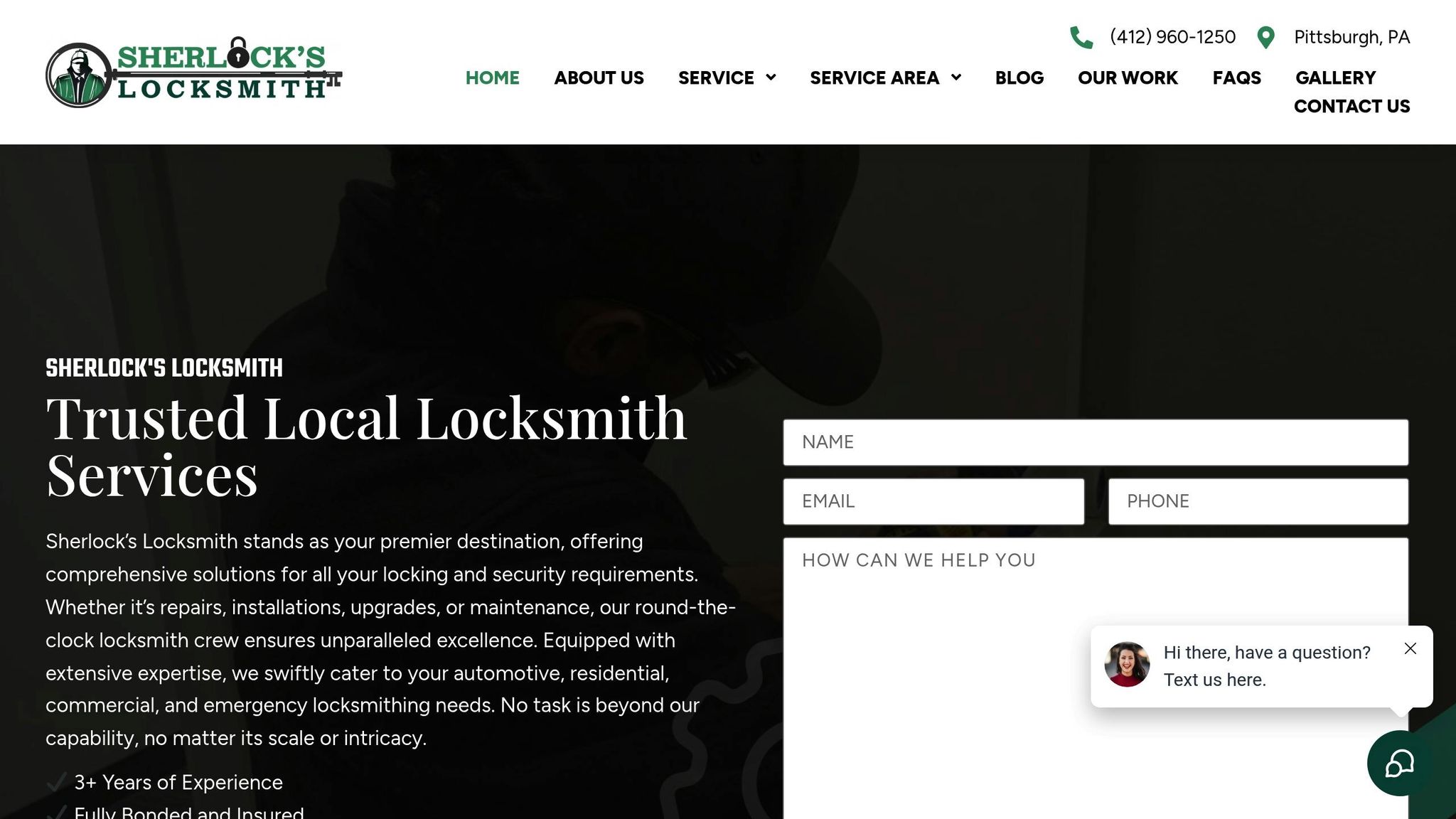
If you’re looking for a provider that checks all these boxes, Sherlock’s Locksmith is a standout option. Serving businesses in Pittsburgh, PA, they bring together traditional locksmith services and modern security system expertise. Their certified technicians understand how to integrate video monitoring systems with other security components, such as access control systems and electronic locks.
With 24/7 mobile service, Sherlock’s Locksmith is ready to address security system issues at any time. Whether it’s a malfunctioning camera disrupting your surveillance or an urgent need to integrate new monitoring equipment with existing locks, their team is available around the clock. This level of availability is particularly useful for businesses that operate outside standard hours or handle sensitive operations requiring constant oversight.
Sherlock’s Locksmith also leverages advanced security tools and technologies. Their technicians specialize in keyless entry systems, biometric locks, and alarm systems that integrate seamlessly with video monitoring platforms. This means you can rely on a single provider to create a cohesive security ecosystem, eliminating the hassle of coordinating with multiple vendors.
Their expertise extends beyond installation. Sherlock’s Locksmith offers commercial locksmith services that include security consulting. This is especially helpful when planning the placement and integration of video monitoring systems. By understanding how physical security measures like master key systems and access controls complement surveillance, they help businesses develop well-rounded security strategies.
Combining emergency locksmith services with cutting-edge security system knowledge, Sherlock’s Locksmith provides comprehensive support. Whether you’re installing a new remote video monitoring system or upgrading your current setup to better integrate with existing locks and access controls, they can handle both the physical and electronic aspects of your project. This all-in-one approach makes them a reliable partner for businesses seeking robust security solutions.
Conclusion
Remote video monitoring has transitioned from being a luxury to becoming a critical tool for modern businesses. This guide has shown how advanced systems – featuring high-definition cameras, smart analytics, and cloud-based storage – offer more than just surveillance. They provide a comprehensive security framework that meets the demands of today’s businesses.
The real power of remote video monitoring lies in creating an integrated security network. It’s not just about installing cameras; it’s about designing a system that enhances response times, lowers operational costs, and delivers valuable insights to improve daily operations.
To achieve these benefits, professional installation and integration are key. While DIY setups might seem appealing, the complexity of modern systems – especially when paired with existing infrastructure like access controls or alarms – often requires expert knowledge. A skilled provider ensures your system is not only functional but also scalable, adapting as your business grows.
By working with experienced professionals like Sherlock’s Locksmith, you can ensure seamless integration of your video monitoring system with other security measures. Their expertise in both traditional locksmith services and modern security tech offers a holistic solution, addressing physical and electronic security needs under one roof.
Investing in remote video monitoring offers long-term rewards, including better security, streamlined operations, and greater peace of mind. With advancements like artificial intelligence and enhanced mobile access on the horizon, adopting these systems now helps future-proof your business while protecting your assets today.
Opt for a security solution that works tirelessly, provides actionable insights, and evolves with your needs. When thoughtfully designed, installed, and managed, remote video monitoring delivers all this and more.
FAQs
How do remote video monitoring systems work with existing security measures to improve business safety?
Remote video monitoring systems work effortlessly with your current security setup – whether it’s access control systems, alarms, or CCTV cameras – bringing everything together into a cohesive and efficient security network. This kind of integration unlocks features like real-time alerts, automated threat detection, and coordinated responses, allowing you to address potential security issues faster and more effectively.
Pairing remote monitoring with traditional security measures, such as on-site guards or alarm systems, boosts both threat prevention and day-to-day efficiency. This layered strategy not only strengthens your security but also offers the reassurance of knowing your business is under constant protection.
What’s the difference between on-site and cloud storage for video monitoring, and how do I choose the right option for my business?
The key distinctions between on-site storage and cloud storage for video monitoring come down to control, scalability, cost, and security.
With on-site storage, you have complete control over your data. It allows for quicker access since it doesn’t rely on an internet connection. This option is often more budget-friendly for handling high-resolution video or managing extensive camera systems. However, it does come with some drawbacks – it requires regular maintenance and is susceptible to risks like physical damage or theft.
Cloud storage, by contrast, provides flexibility and remote access, letting you view your footage from anywhere as long as you have an internet connection. It’s easier to scale up as your needs grow and offers added protection against local physical risks. That said, cloud storage usually comes with recurring subscription fees and relies heavily on consistent internet performance.
Choosing the right option depends on your specific needs. Think about your budget, how much control you want over your data, your security concerns, and whether immediate local access or remote flexibility better aligns with your goals.
How can businesses secure remote access to their video monitoring systems and protect against cyber threats?
To keep your video monitoring systems secure and shield them from cyber threats, start with multi-factor authentication (MFA) and enforce the use of strong passwords that are updated regularly. These measures ensure that only authorized users can access the system.
Instead of relying on port forwarding, opt for a VPN (Virtual Private Network) to establish a secure connection. Additionally, encrypt video data during both transmission and storage to safeguard sensitive information. Make it a habit to update your software and firmware frequently – this helps fix vulnerabilities and protects against emerging threats.
Another crucial step is network segmentation. By isolating your video monitoring system from other parts of your network, you reduce the risk of unauthorized access. Keep an eye on activity logs to detect any unusual behavior. Don’t overlook physical security either – protecting cameras, servers, and other devices is essential for a well-rounded defense.




